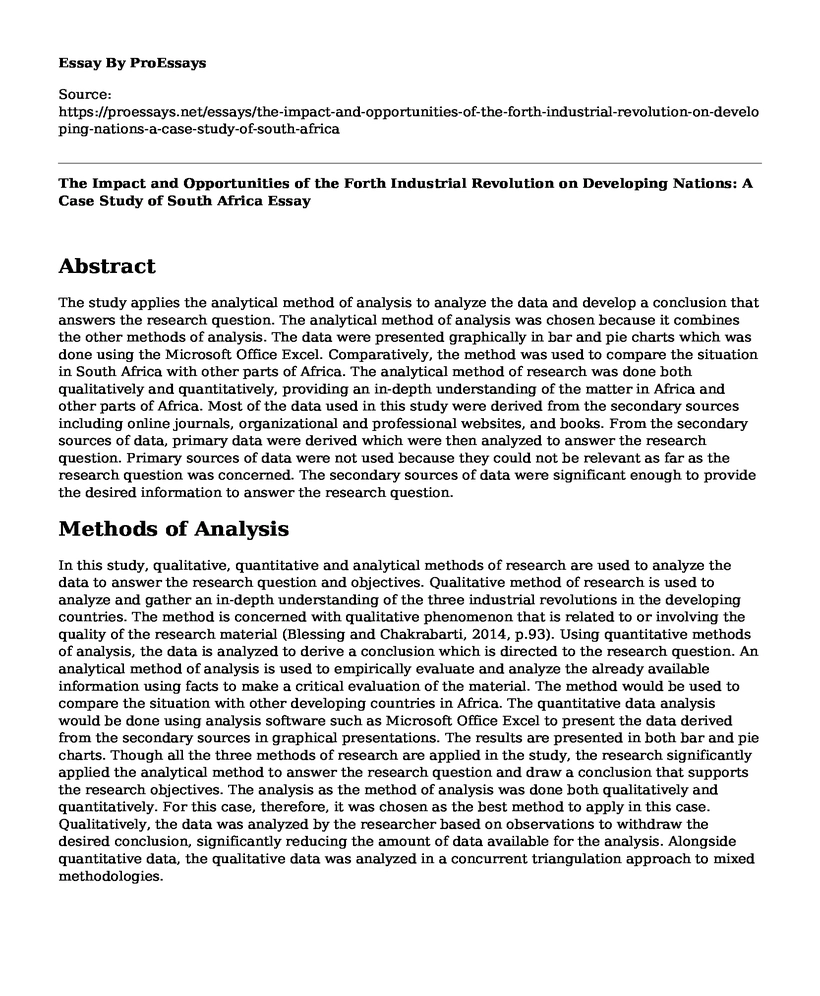Abstract
The study applies the analytical method of analysis to analyze the data and develop a conclusion that answers the research question. The analytical method of analysis was chosen because it combines the other methods of analysis. The data were presented graphically in bar and pie charts which was done using the Microsoft Office Excel. Comparatively, the method was used to compare the situation in South Africa with other parts of Africa. The analytical method of research was done both qualitatively and quantitatively, providing an in-depth understanding of the matter in Africa and other parts of Africa. Most of the data used in this study were derived from the secondary sources including online journals, organizational and professional websites, and books. From the secondary sources of data, primary data were derived which were then analyzed to answer the research question. Primary sources of data were not used because they could not be relevant as far as the research question was concerned. The secondary sources of data were significant enough to provide the desired information to answer the research question.
Methods of Analysis
In this study, qualitative, quantitative and analytical methods of research are used to analyze the data to answer the research question and objectives. Qualitative method of research is used to analyze and gather an in-depth understanding of the three industrial revolutions in the developing countries. The method is concerned with qualitative phenomenon that is related to or involving the quality of the research material (Blessing and Chakrabarti, 2014, p.93). Using quantitative methods of analysis, the data is analyzed to derive a conclusion which is directed to the research question. An analytical method of analysis is used to empirically evaluate and analyze the already available information using facts to make a critical evaluation of the material. The method would be used to compare the situation with other developing countries in Africa. The quantitative data analysis would be done using analysis software such as Microsoft Office Excel to present the data derived from the secondary sources in graphical presentations. The results are presented in both bar and pie charts. Though all the three methods of research are applied in the study, the research significantly applied the analytical method to answer the research question and draw a conclusion that supports the research objectives. The analysis as the method of analysis was done both qualitatively and quantitatively. For this case, therefore, it was chosen as the best method to apply in this case. Qualitatively, the data was analyzed by the researcher based on observations to withdraw the desired conclusion, significantly reducing the amount of data available for the analysis. Alongside quantitative data, the qualitative data was analyzed in a concurrent triangulation approach to mixed methodologies.
Sources of Data
According to Bryman and Bell (2015), the two sources of data are primary and secondary sources. However, in this study, only the secondary sources of data are implemented in answering the research question as it is only the sources that contributed to objectives and were used to generate conclusions and recommendations. Secondary sources of data refer to those sources that were not originally gathered by the study and are derived from data that already exists (Morales and Ladhari, 2011, p.253). For this study, the data was derived from a variety of online databases of journals, research projects by organizations, books, and professional websites. From the secondary data were derived primary data to help find the solution for the research questions. Documents with relevant information about the unemployment rates in South Africa were requested, as well as the internal organizational surveys about the employees' level of education and field of profession.
References
Al, S. (2013). Interpretive research design: concepts and processes. International Journal of Social Research Methodology, 16(4), pp.351-352.Blessing, L. and Chakrabarti, A. (2014). Drm, a design research methodology. Heidelberg: Springer.
Bryman, A. and Bell, E. (2015). Business Research Methods. Oxford: Oxford University Press.
Morales, M. and Ladhari, R. (2011). Comparative crosscultural service quality: an assessment of research methodology. Journal of Service Management, 22(2), pp.241-265.Research-Methodology. (2018). Research Design - Research Methodology. [online] Available at: https://research-methodology.net/research-methodology/research-design/ [Accessed 12 May 2018].
Cite this page
The Impact and Opportunities of the Forth Industrial Revolution on Developing Nations: A Case Study of South Africa. (2022, May 23). Retrieved from https://proessays.net/essays/the-impact-and-opportunities-of-the-forth-industrial-revolution-on-developing-nations-a-case-study-of-south-africa
If you are the original author of this essay and no longer wish to have it published on the ProEssays website, please click below to request its removal:
- Interactive Research of the Letters between John and Abigail Adams
- The Race for Natural Resources in the 19th Century Africa Essay
- Historical Changes That Impacted the Practice of Slavery Essay
- Essay Sample on Portraits of Simonetta Vespucci
- Essay Example on Season of Migration to the North: Reflection of Modernism in Africa
- War As a Social Invention: Margaret Mead & William James's Views - Essay Sample
- Essay Example on Cold War: US-USSR Power Tension After WWII







